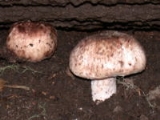
Agaricus subrutilescens
Encyclopedia
Agaricus subrutilescens, also known as the wine-colored Agaricus, is a mushroom
of the genus Agaricus
. This mushroom is a good edible
. It was first described scientifically in 1925 as Psalliota subrutilescens, and later transferred to Agaricus in 1938.
that is 5 – across, dry, and has many and wine to brown colored fibers, especially near the center. The gills are close and white at first, turning dark brown in age. The stalk
has a skirt-like ring
and is 4 to 20 cm (1.6 to 7.9 in) long, 1 – thick, long, white, and covered with soft woolly scales. The flesh
is white and does not stain, and the odor and taste is pleasant.
The purplish fibrous cap and shaggy white stem differentiate this mushroom from others which resemble it.
, pine
, or alder
.
Mushroom
A mushroom is the fleshy, spore-bearing fruiting body of a fungus, typically produced above ground on soil or on its food source. The standard for the name "mushroom" is the cultivated white button mushroom, Agaricus bisporus; hence the word "mushroom" is most often applied to those fungi that...
of the genus Agaricus
Agaricus
Agaricus is a large and important genus of mushrooms containing both edible and poisonous species, with possibly over 300 members worldwide...
. This mushroom is a good edible
Edible mushroom
Edible mushrooms are the fleshy and edible fruiting bodies of several species of fungi. Mushrooms belong to the macrofungi, because their fruiting structures are large enough to be seen with the naked eye. They can appear either below ground or above ground where they may be picked by hand...
. It was first described scientifically in 1925 as Psalliota subrutilescens, and later transferred to Agaricus in 1938.
Description
Agaricus subrutilescens has a capPileus (mycology)
The pileus is the technical name for the cap, or cap-like part, of a basidiocarp or ascocarp that supports a spore-bearing surface, the hymenium. The hymenium may consist of lamellae, tubes, or teeth, on the underside of the pileus...
that is 5 – across, dry, and has many and wine to brown colored fibers, especially near the center. The gills are close and white at first, turning dark brown in age. The stalk
Stipe (mycology)
thumb|150px|right|Diagram of a [[basidiomycete]] stipe with an [[annulus |annulus]] and [[volva |volva]]In mycology a stipe refers to the stem or stalk-like feature supporting the cap of a mushroom. Like all tissues of the mushroom other than the hymenium, the stipe is composed of sterile hyphal...
has a skirt-like ring
Annulus (mycology)
An annulus is the ring like structure sometimes found on the stipe of some species of mushrooms. The annulus represents the remaining part of the partial veil, after it has ruptured to expose the gills or other spore-producing surface. An annulus may be thick and membranous, or it may be cobweb-like...
and is 4 to 20 cm (1.6 to 7.9 in) long, 1 – thick, long, white, and covered with soft woolly scales. The flesh
Trama (mycology)
In mycology trama is a term for the inner, fleshy portion of a mushroom's basidiocarp, or fruit body. It is distinct from the outer layer of tissue, known as the pileipellis or cuticle, and from the spore-bearing tissue layer known as the hymenium....
is white and does not stain, and the odor and taste is pleasant.
The purplish fibrous cap and shaggy white stem differentiate this mushroom from others which resemble it.
Habitat and distribution
The mushroom fruits in undisturbed mixed woods in Western North America and Japan. It grows by itself or scattered in small clusters, often under redwoodRedwood
-Trees:Conifers* Family Cupressaceae *** Sequoia sempervirens - coast redwood**** Albino redwood*** Sequoiadendron giganteum - giant sequoia*** Metasequoia glyptostroboides - dawn redwood* Family Pinaceae...
, pine
Pine
Pines are trees in the genus Pinus ,in the family Pinaceae. They make up the monotypic subfamily Pinoideae. There are about 115 species of pine, although different authorities accept between 105 and 125 species.-Etymology:...
, or alder
Alder
Alder is the common name of a genus of flowering plants belonging to the birch family . The genus comprises about 30 species of monoecious trees and shrubs, few reaching large size, distributed throughout the North Temperate Zone and in the Americas along the Andes southwards to...
.

